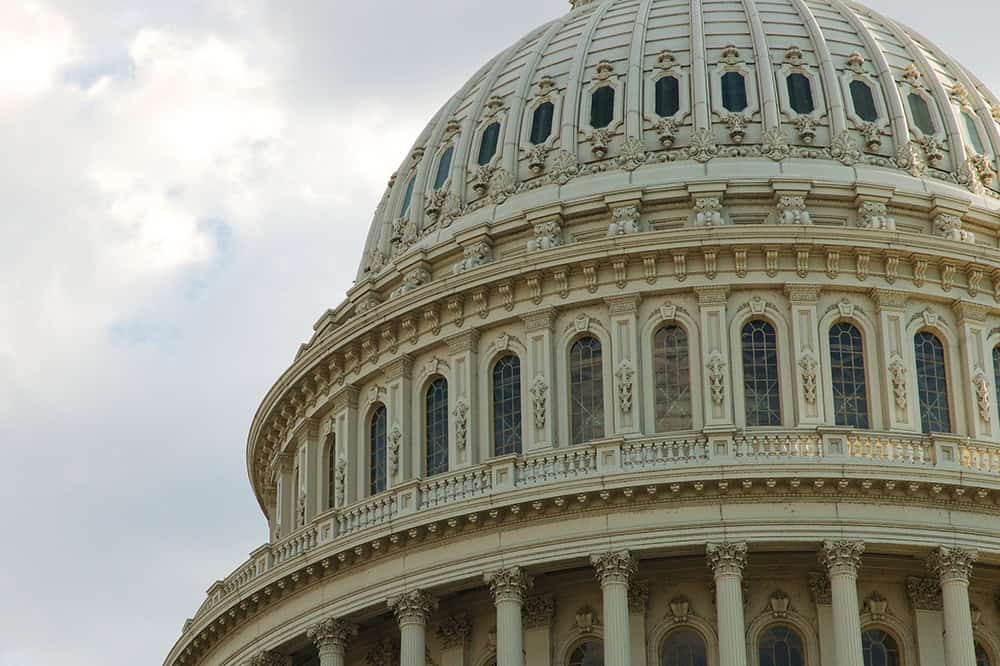Can a Rescissions Package Help Lawmakers Formalize DOGE Cuts?
Last Updated April 1, 2025
There has recently been significant discussion surrounding spending cuts proposed by the Department of Government Efficiency (DOGE), including questions about how and whether cuts identified by DOGE can translate into deficit reduction. Additionally, there have been questions raised about the role of DOGE with respect to the legislative branch’s “power of the purse.”
Given the country’s daunting fiscal outlook, America’s leaders should look for opportunities to improve government efficiency and find savings wherever they can. One key way to find significant savings is by targeting waste, fraud, and abuse. The General Accountability Office (GAO) reported $162 billion in improper payments in 2024 alone — a staggering amount compared to reported historical levels before 2019. Moreover, GAO has estimated that the federal government could lose as much as $521 billion annually to fraud.
DOGE has identified many areas for spending cuts and potential savings — including contract cancellations, asset sales, and other reductions — that could generate reserves within government agency accounts.
However, the Executive Branch cannot simply reallocate this funding for other priorities, as legislation imposes strict limits on how appropriated monies can be spent. In order to achieve actual cost savings, the President can pursue a rescission process outlined in the Impoundment Control Act (ICA) to request that Congress formally rescind budget authority of specific programs or contracts.
While rescission authority has not been used meaningfully in the past, it does represent one statutory tool available for lawmakers to retract spending that was previously approved. A rescissions package could be a step in the right direction to improve the country’s deficits, while ensuring Congress’s participation in the process.
What Are Rescissions?
Proposed by the President for approval by Congress, rescissions are requests to cancel all or part of allocated budget authority. Rescissions target unobligated funds, which are dollars previously appropriated by Congress, but not formally obligated by a government agency. Ultimately, these rescissions can lead to savings for the federal government that could help reduce the budget deficit.
The Impoundment Control Act (ICA) governs the process for rescissions in a given fiscal year. Under this law, the President must transmit a special message to both the House and Senate. That message should include the requested amount of budget authority to be rescinded, the specific accounts or functions, justifications for the rescissions, and other details for Congress to evaluate. Legislation to address the rescission request can be considered with limited debate in each house of Congress and a simple majority in the Senate (rather than the supermajority often required to end debate for legislation). Congressional action on the bill must finish before the end of a 45-calendar-day period of continuous session beginning with the President’s transmittal of a rescission package; otherwise, the proposal is rejected. During those 45 days, the funding subject to potential rescission is effectively frozen.
What Types of Funds Can the President Ask Congress to Rescind?
Rescission authority under the ICA only applies to funding provided through the appropriation process. Such funding, also known as discretionary spending, accounted for 27 percent or $1.8 trillion of federal outlays in 2024. Defense programs represent nearly half of total discretionary spending. Other major activities funded through appropriations include homeland security, education, transportation, research, food safety, science and space programs, disaster assistance, environmental protection, public housing, and federal law enforcement. Appropriated spending generally does not include spending that is mandatory under law, such as Social Security and Medicare.
History of Congressional Rescissions
Prior to the ICA and beginning with President Jefferson, Presidents used impoundment as a tool to advance policy and economic goals, but these were routine and relatively small in scale. President Nixon dramatically increased the use of impoundments to advance his policy goals, withholding more than a third of all domestic discretionary spending in 1973. This sweeping interpretation of the Executive’s authority to impound funds is what prompted Congress to enact the ICA — to reassert Congress's "power of the purse" and ensure that the executive branch could not unilaterally withhold or delay the expenditure of funds.
Before the first Trump administration, rescission authority had not been used since 2000, when President Clinton requested $6.7 billion in rescissions. Only $3.6 billion of those proposed rescissions were accepted by Congress.
According to GAO, rescissions proposed by administrations from President Ford to Trump (first term) totaled $119.4 billion, of which Congress approved $22.7 billion. President Reagan and Trump submitted most ($43.4 and $42.2 billion, respectively) of all rescissions requested over the last 50 years. Presidents George W. Bush, Obama, and Biden requested none.
Most recently, during President Trump’s first administration, he transmitted a special message to Congress proposing rescissions from 38 appropriation accounts. Ultimately, the President amended his initial special message by withdrawing four and revising six rescission proposals. The final rescission request targeted 34 appropriation accounts and totaled $14.8 billion. Congress did not enact any of the 34 proposals.
In January 2021, President Trump submitted a second rescission request to Congress, rescinding budget authority from 73 accounts, totaling $27.4 billion. However, the Congress did not enact any of the proposals.
Conclusion
Rescission packages can serve as a tool for the President and Congress to manage and control government spending through a formal statutory process. Rescissions target unobligated funds that have not yet been spent or promised through binding agreements. By canceling these funds, the government can reduce overall spending levels, which can help reduce the federal deficit and improve fiscal responsibility.
Rescission authority has its limits, as it only can be applied to discretionary programs, which represent only about a quarter of all federal spending. Some of the largest drivers of spending growth — such as Social Security, Medicare, and Medicaid — are excluded from this process and achieving cost savings within these programs would require broader budget reform.
Even so, using the rescission process is a step in the right fiscal direction, whether used to codify cuts targeted by DOGE or other executive branch actions. The nation’s $36 trillion national debt is large and growing — lawmakers should take advantage of every chance they have to establish a more sustainable fiscal path.
Photo by Samuel Corum/Getty Images
Further Reading
How Much Can the Administration Really Save by Cutting Down on Improper Payments?
Cutting down on improper payments could increase program efficiency, bolster Americans’ confidence in their government, and safeguard taxpayer dollars.
How Do Quantitative Easing and Tightening Affect the Federal Budget?
The Federal Reserve plays an important role in stabilizing the country’s economy.
What Is a Continuing Resolution?
A continuing resolution is a temporary funding measure that Congress can use to fund the federal government for a limited amount of time.


